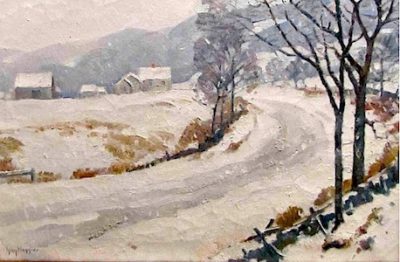
What is landscape? Based on the original definition, it’s only the human modifications in the scene in the painting above, a detail from “Mantle of Winter,” 1921, Guy C. Wiggins, Oil on canvas, Louise Crombie Beach Collection, William Benton Museum of Art, UConn.
Mark Twain once wrote. “The difference between the right word and almost the right word is like the difference between lightning and the lightning bug.”
Geoscientists use the word “landscape” with carefree abandon. We do so under the guidance of our beloved Glossary of Geology published by the American Earth Sciences Institute, and updated online since the 2011 edition, edited by K.E. Klaus K.E., J.P. Mehl, and J.A. Jackson.
Landscape
- (land′-scape) The distinct association of landforms, esp. as modified by geologic forces, that can be seen in a single view, e.g. glacial landscape.
By this definition, landscape is a visual scene containing geological landforms with no connotation of human culture. After 42 years of teaching, however, I recently stumbled across a better definition, one exquisitely appropriate for the Anthropocene Epoch.
My new source is the highly authoritative book What is Landscape? by John R. Stilgoe, the Robert and Lois Orchard Professor in the History of Landscape at the Visual and Environmental Studies Department of Harvard University (MIT Press, 2015). Its first line is: “Landscape is a noun,” which “designates the surface of the earth people shaped and shape deliberately for permanent purposes.” To validate his definition, he excavates the word’s etymology using my favorite book, the Oxford Dictionary of the English Language (OED), which traces all 600,000 words of the world’s default language back through more than millennia of usage:
-
- Landscape comes from the old Frisian language of what is now the coast of the Netherlands and the North Sea coast of Germany. … the word once meant
shoveled land
-
- , land thrown up against the sea.
Schop
-
- is an old word still vibrant in modern Dutch; it means shovel. Seamen introduced
landscop
-
- to sixteenth century alongshore Englishmen who misunderstood or mangled its pronunciation … [to]…
landskap
-
- or l
andskep
-
- , then
landskip,
-
- then
landscape
- .
The key idea — confirmed by lexicographers– is that landscapes are landscops or shovel-scapes. These are the landforms made from the material units we geologists arrogantly and inappropriately call “artificial fill” on official U.S. Geological Survey maps, including our Connecticut state maps and the GIS data layers derived thereof. This makes the tall flood dikes that protect our capitol city of Hartford true landscapes relative to the places we’ve merely trammeled, flattened, and built buildings on. Ditto at a smaller scale for the stone walls that crisscross our woodlands. They are landscapes. And there’s nothing artificial about them.
I write not to persuade you to give up on our “misunderstood or mangled” use of the word landscape because it’s one of our discipline’s favorite words. Instead, I write to ask you to think about this word in a new way. An Anthropocene way.
As you probably know already, humankind, using the power of fossil fuels, has become Earth’s most potent agency, moving “land” at a faster rate than all others. Indeed, the surface of our planet is largely a makeover or gloss of its pre-human condition, a “shoveled surface” truer to the original use of the word landscape than all the so-called wildernesses combined.
So, to the lexicographers who continuously compile the Oxford English Dictionary, our landscapes are shovel-scapes. The same is true for the compilers of the Glossary of Geology, provided we take the human agency into account.